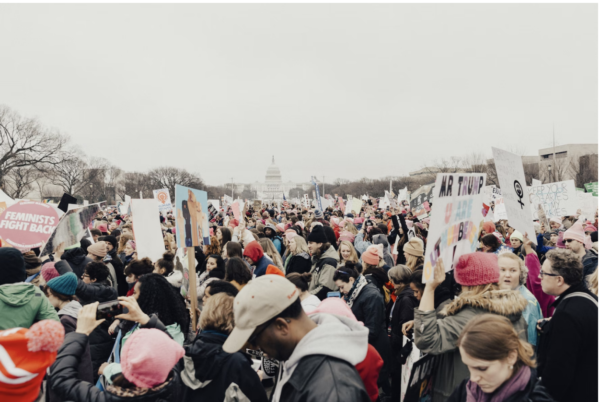Feminism - A Tool To Empower Women
Women’s March on Washington - Unspalsh
Feminists have challenged sexism in many levels of society, particularly in terms of exploitation, harassment, and objectification of women. Many of these violent experiences women face can be traumatizing. Feminism, in terms of resistance to patriarchy, often occurs in subtle and individualistic ways. However, collective resistance is another way for many women, who identify as feminists, to challenge societal norms and power structures that challenge sources of male privilege. Feminism today is the result of a long, arduous struggle of women using different tactics and intensity to create social movements through changes in “legislation, social norms, and perceptions of proper gender roles” (Swank and Fahs, 2017).
As I speak about feminism, it is imperative I provide a brief history of the different waves of feminism; showing differences in tactics women used in efforts for gender equality. The first wave of feminism occurred at the Seneca Falls Convention where hundreds of men and women rallied for women equality (Feminism, 2022). The second wave unraveled in the context of the civil rights movement. In this phase, much focus was on the Equal Rights Amendment prompting social equality regardless of sex (Feminism, 2022). In addition, sexuality and reproductive rights were presiding topics; within a year, the Supreme Court’s decision in regards to Roe v. Wade, permitting women to practice their reproductive rights. Although the first and second wave of feminism focused solely on white, cisgender, western, and middle class women, the third wave was more inclusive in terms of race and gender. (Feminism, 2022). This wave tackled issues that continued to exist such as sexual harassment in the workplace and the lack of women in positions of power. All these waves have played a major role in allowing all women of all color, races, and gender identities, to be given rights and treated equal to their male counterparts.
Many feminists believe violence against women is the result of misuse of power by men who have been socialized to believe they have more rights than women. It is known that the root of interpersonal violence is the need for power (Walker, 1989). Although the need for power may hold truth, feminists on the other hand, believe violence against women is at the core of all violence and is often applied to men’s need to control others (Walker, 1989).
Discrimination based on gender and oppression of women has made women more vulnerable to mental health problems (Walker, 1989). A major area of vulnerability is found in ‘large numbers of women who have been victims of men’s violence either as children or as adults’ (Walker, 1989). Feminist theorists were able to use this research and design interventions, especially for women survivors. Interventions and awareness are crucial to reduce violence against women. Violence is maintained by ineffective responses to protect women from institutions or cultural factors that devalue women.
In my personal life, I have experienced gender based violence as well. I used to have a male friend who I thought I was close to. We were both STEM students in the same undergraduate college, and both had aspirations of contributing to healthcare. We were also in a larger group of friends who also were interested in STEM. The more I got to know them, the more comfortable they got, the more their “jokes” slowly started reaching to low levels of insults. It seemed as if their jokes were a way to control their female friends and label them anything but positive. These jokes started off as picking at one of my female friends and joking about how she couldn’t get the lecture material as quickly as “the boys” in the group. The boys didn’t learn much or even try to learn from my female friend during group study sessions and would often cut her off. I didn’t have much experience with being friends with men, and my female friend didn’t say anything to those male friends- who she has been close with much longer than I had been. During the term, I noticed when test scores were released, if my female friend had a higher score, the men of our friend group had a certain level of animosity and were short fused with her. This shows a level of discrimination of men towards their successful female counterparts, even within the friendship sphere. I will never know if this level of bias and negative behavior was because of my male friend’s intention or if he didn’t know he was playing into male dominance, however, these interactions were far from healing and growing a friendship.
As time went on with this friend group, there was a day where all of our friends were sitting in the library chatting with each other. All of a sudden the topic of prom came up and we were talking about certain couples leaving their dates to dance with another person. Yes, that scenario is disrespectful, but that same male friend that I had, instantly said “if that happened to me, I would have slapped that girl”. The other friends in that friend group started laughing and went along with the joke. I was completely appalled by that sentence and wanted to say something about it. All I could muster out of my mouth was “Oh my goodness, that is so mean!”. The male friend then justified his answer and became even more aggressive with his words. He would cut me off when I tried to say that hitting women is horrible, and hitting people in general is bad. No one from that friend group backed me up, and most of those friends were men.
Just like my friend who witnessed gender based violence and felt uncredible while she was trying to add to a lecture discussion, I too felt like what I was saying was not worth their time. It felt like what the male friend had to say was more important and reliable, even though he was far from it. That interaction left me feeling confused, doubtful, and most of all hurt. Not only was what he said incredibly harmful and can be seen as a sign of future abuse, but also what I had to say was not important.
Ever since that interaction, I have distanced myself from him. I know these experiences have affected me in the way I live my life now: I have distrust in new friends and I was very quiet during class. Not until recently in a new class I am taking, did I feel the confidence to answer questions and provide reasoning on why I think that. That class made it very clear that gender equality is valued and that everyone should be given a space to express their thinking. I feel that when I answer a question now, I have confidence that what I say is meaningful and adds to the discussion. I feel respected by my peers, especially by my male counterparts. This new interaction has made me feel empowered in myself and confident in my learning and speaking about important topics.
Even though trauma and abuse of power is part of reality, there should be more efforts in providing gender equality and involvement in healing from abuse. According to Lenore Walker, an American psychologist, preventative mental health techniques build a woman’s self esteem by focusing on the development of competency skills. Empowering women by providing them the same opportunities to men and maintaining gender equality, will lead to a safer and more equitable future.
About the author
Maham is a recent Portland State University alumni, receiving her Bachelor of Science in Public Health and minor in Anthropology. She is an activist and feminist, standing up for women’s rights and increasing awareness of domestic violence. As a woman and person of color, her life work is dedicated to creating mental health awareness and increasing diversity in healthcare areas. In her downtime, Maham is often painting or getting food with her friends.


